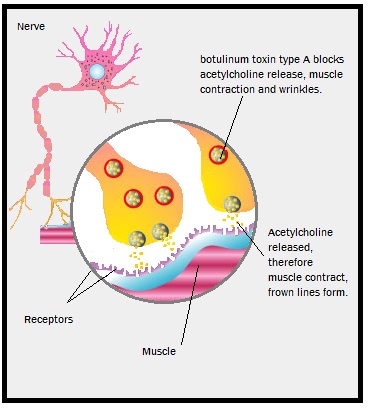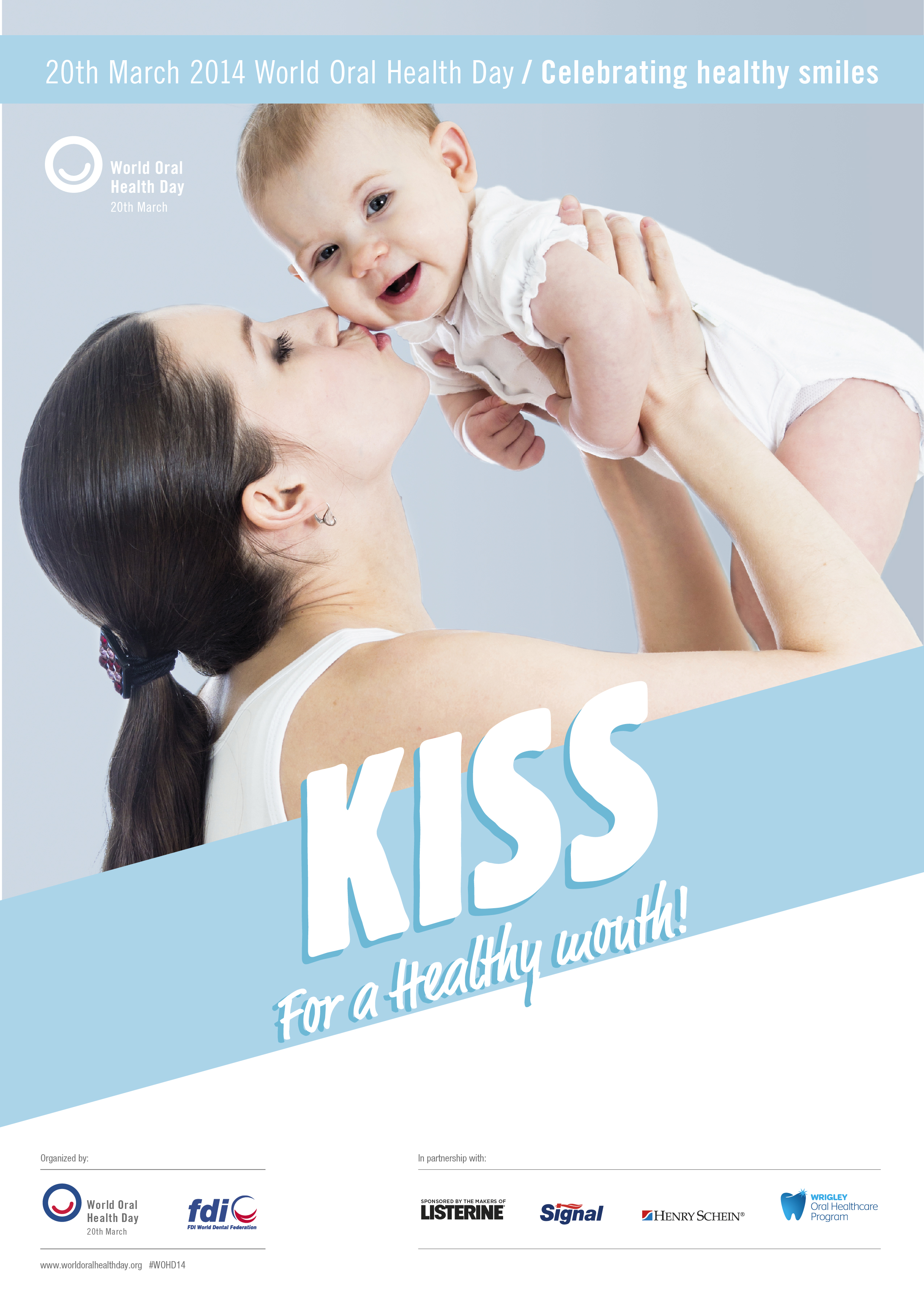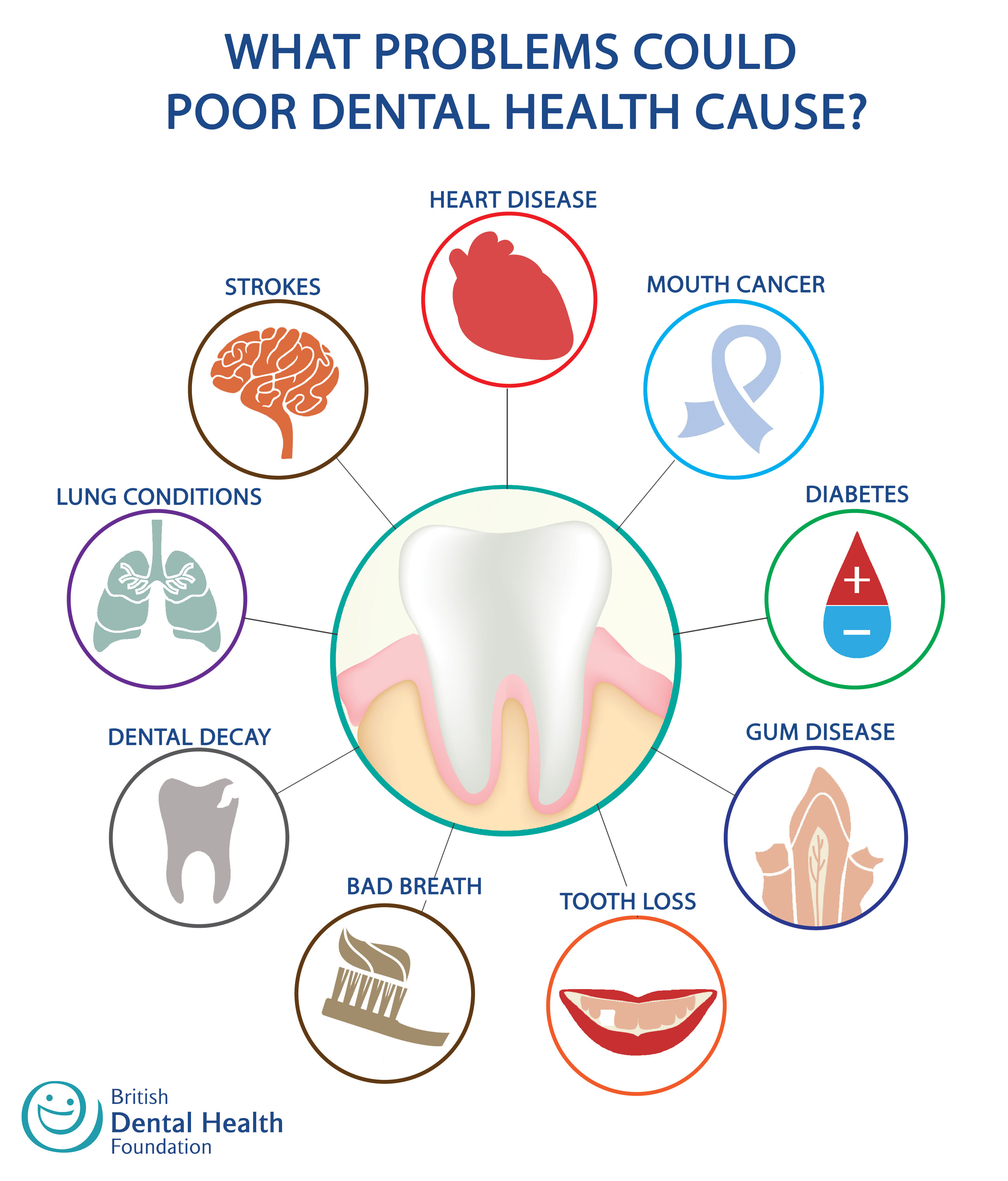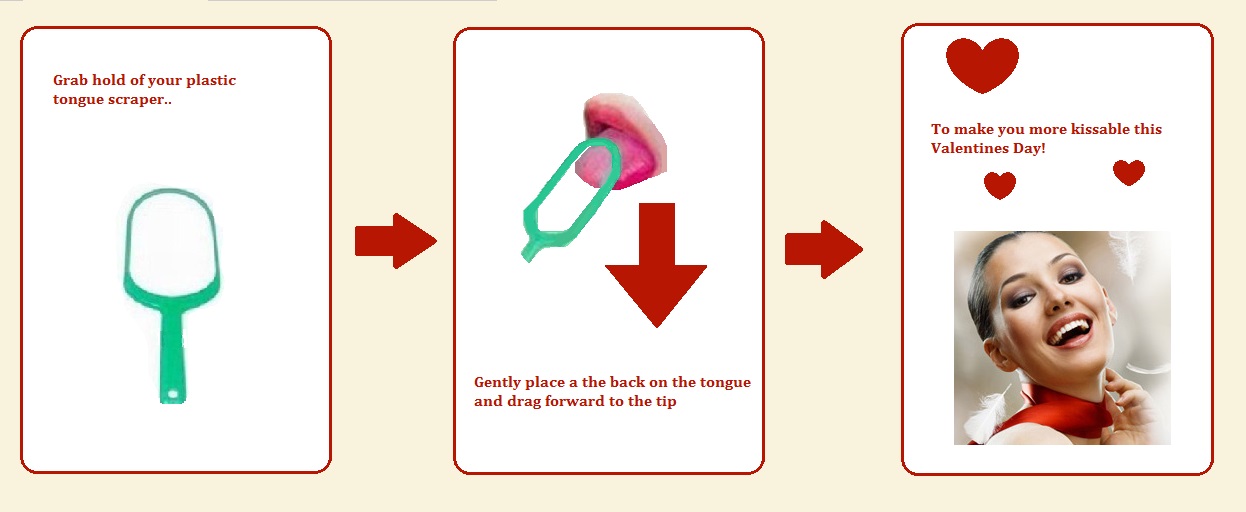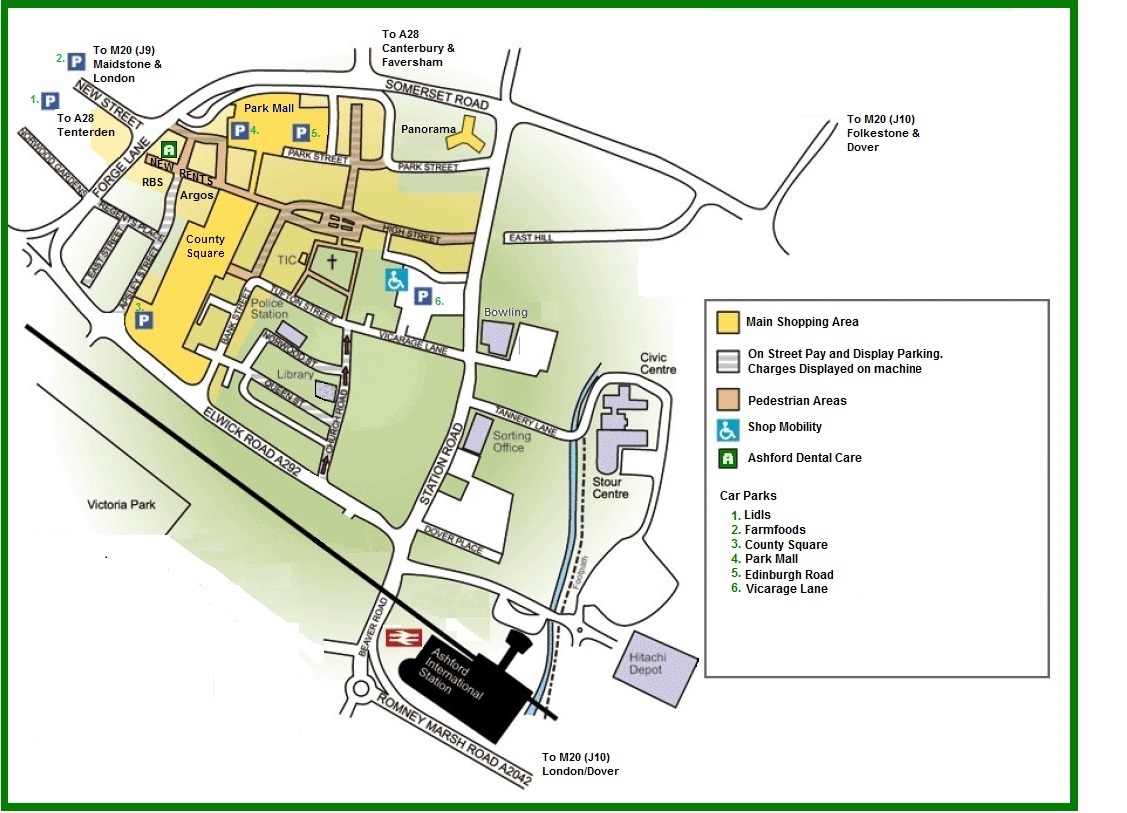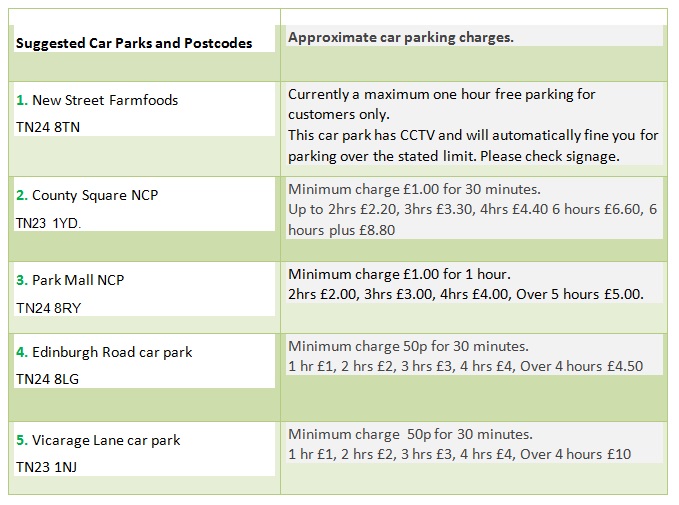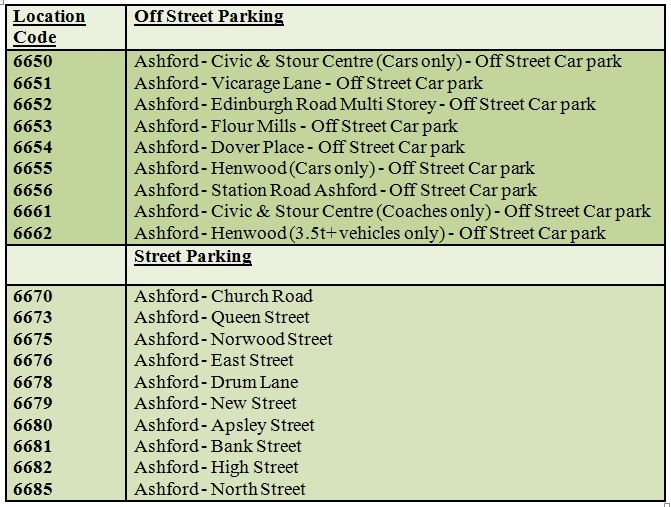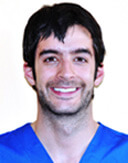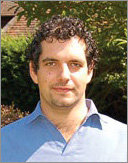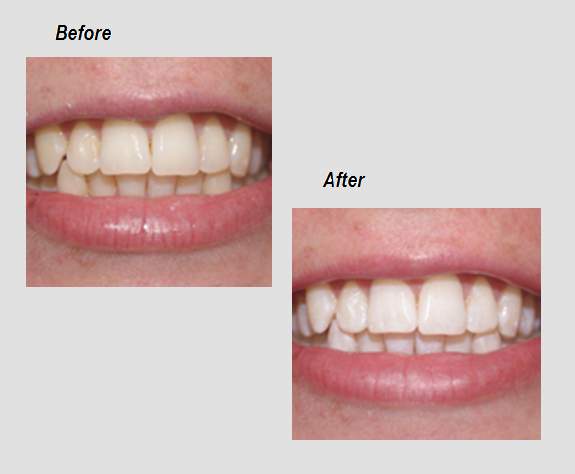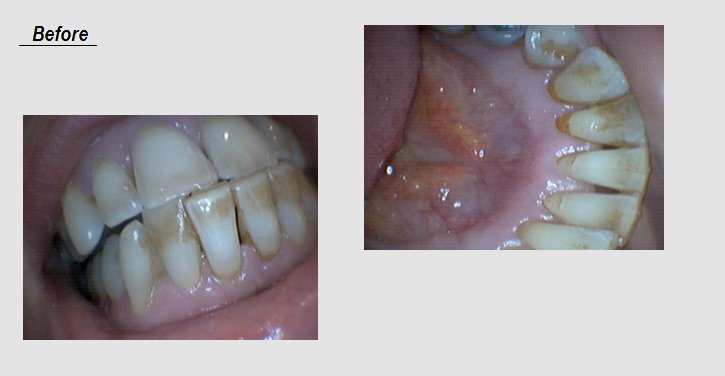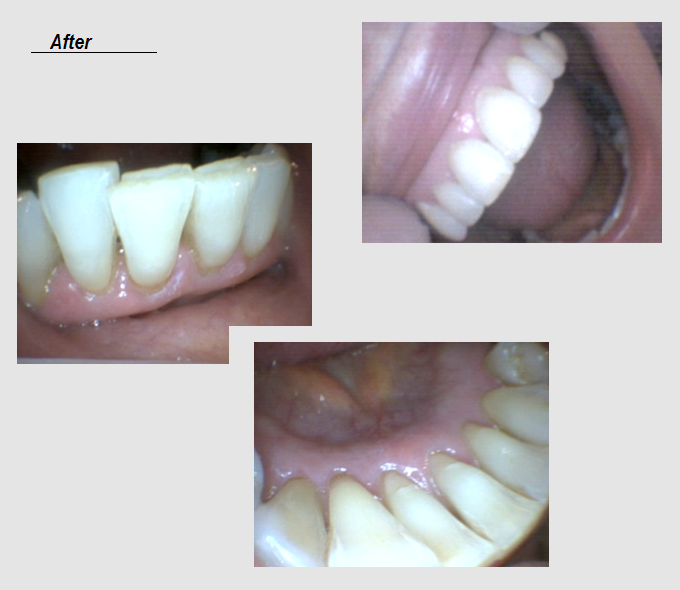Broken teeth
The main reasons for broken and fractured teeth include aging or incorrect fillings, bad bite, grinding/clenching or eating very hard food on a weak portion of your tooth or filling.
Several solutions include:
Recontouring
Cosmetic contouring is a cost-effective and minimally invasive way to repair small chips or fractures in teeth
Cosmetic contouring may be the best option if you:
- Have a very small fracture or chip in your tooth
- Want to invest a minimal amount if time and money in the procedure
- Have teeth that are long enough that contouring will not make them appear too short, aged, and/or worn
Composite Filling
If the cavity left by the removed decay or filling isn’t too large, composite resin can provide a cosmetically appealing filling alternative, particularly in lower back teeth that show when you smile or laugh.
Tooth-colored composite resin offers a conservative but esthetic approach to filling cavities. A composite filling may be the best option if you:
Are getting a small filling in an area that is visible during smiling or talking
Want to keep cost and time of treatment to a minimum
Are willing to accept an option with reduced longevity and resistance to wear and staining
Want to keep as much of your existing tooth structure as possible
Inlays or Onlays
Inlays and onlays are particular types of fillings made of composite resin, porcelain, or gold. An inlay is custom-made to fit the prepared cavity, while an onlay covers the entire chewing surface of the tooth. The primary disadvantage of inlays and onlays is their higher cost relative to traditional composite and amalgam fillings.
Inlays and onlays are durable alternatives for restoring large cavities. An inlay or onlay may be the best option if you:
- Don’t mind spending more time and money to get a long-lasting result
- Have a large cavity to be filled
- Want to avoid staining
What you should know
Gold
doesn’t discolor or stain the teeth and has a longer life expectancy than silver. It can be placed esthetically into upper back teeth ere it doesn’t show; however, it shouldn’t be placed opposite porcelain, because porcelain tends to wear gold rapidly during chewing.
Porcelain
Research shows that bonded porcelain inlays and onlays can equal the strength of natural teeth, making them particularly attractive choices when both esthetics and strength are required. However, extra stress can fracture porcelain just as it can natural teeth.
Composite resin
Although not as long lasting as gold or porcelain, composite resin inlays and onlays are an esthetic and less expensive option.
Porcelain Veneers
Porcelain veneers are a highly esthetic option for restoring front teeth. However, they are more expensive than composite fillings and require reduction of natural tooth structure. Porcelain veneers may be the best option if you:
- Have front teeth with extensive decay or old fillings that are discolored
- Would like to close minor spaces between your front teeth
- Are frustrated by fillings that continue to stain or are too visible
- Want a smile makeover that will improve tooth shape and brighten tooth color
Crowns
Crowns represent a long-lasting treatment alternative involving reducing the tooth and covering the remainder with a custom-made restoration. Although it’s always preferable to preserve the structure of the natural tooth, if a tooth is severely decayed or stained following the removal of a large filling, placing a crown may be the best option.
Crowns can produce near-perfect esthetic results. However, both the cost and the number of office visits required may make this treatment prohibitive for some patients. Crowns may be the best option if you:
- Have extensive decay and/or severe staining following the removal of a large filling
- Are looking for the most beautiful, long-lasting result possible
- Are willing to undergo more extensive treatment and incur higher costs
- Have additional esthetic or functional concerns that can be best addressed with crowns
| Composite Filling |
Inlays or Onlays |
Porcelain Veneers |
Crowns |
| Treatment Time |
| Approximately 1hour per tooth |
Usually 2 office visits; 1-2 hours each per tooth |
2 office visits; 4 hours each |
2-3 office visits; 1-2 hours each per tooth |
| Maintenance |
| Brush and floss dailyUse a fluoride toothpaste and mouthwash as prescribed by your dentistAvoid biting down on hard foods and ice |
Brush and floss dailyUse a fluoride toothpaste and mouthwash as prescribed by your dentistReduce intake of refined sugars and chewy foods such as caramels |
Avoid use of ultrasonic scaler and air abrasives during hygiene office visitsBrush and floss dailyUse a fluoride toothpaste and mouthwash as prescribed by your dentistReduce intake of refined sugars and chewy foods such as caramels |
Brush and floss dailyUse a fluoride toothpaste and mouthwash as prescribed by your dentistReduce intake of refined sugars and chewy foods such as caramels |
| Results |
| Esthetic replacement of old silver fillings or new decay areasMay not be perfect color blend but much improved over metal surfaces |
More conservative than a full crownGold is most functional and longest-lasting method of restoring teeth, but large restorations tend to show metalPorcelain can be a highly esthetic replacement for discoloured or metal posterior fillingsComposite resin can match tooth color well |
Can be highly esthetic but eventually may darken if the underlying tooth structure becomes darker. |
Can achieve the best results in tooth shade, shape and size |
| Treatment Longevity |
| 5-8 years |
Gold: 6-20 years
Porcelain: 5-15 yearsComposite resin: 5-12 years |
5-12 years |
5-15 years |
| Cost |
| £90 to £180 per tooth |
Gold:
£400 to £450 per toothPorcelain:
£400 to £600 per toothComposite resin:
£120 to £180 per tooth |
£400 to £600 per tooth |
£400 to £600 per tooth |
| Advantages |
| Esthetic (tooth-colored)InsulatingCompleted in 1 office visitExtremely good bond to tooth structureLess expensive than crowns or inlays
More conservative than crowns because less tooth reduction required |
Well-suited for large cavitiesGold:
Longest lasting
Wears more like tooth structure
Will not fracturePorcelain:
Esthetic (tooth-colored)
Stronger than posterior composite resin
Extremely good bond to tooth structure
Will not stain
InsulatingComposite resin:
May be less expensive than other options |
Excellent bond to enamelLess tooth reduction required than crowningColor change is possibleLess staining than bonding |
The dentist can improve shape of teethSome realignment or straightening of teeth is possibleCan be all-ceramicThe greatest esthetic change is possible with this option |
| Disadvantages |
| More expensive than amalgamWears easilyCan stain, chip, or fractureMay have a shorter life expectancy than silver, gold, or porcelainLess suited for large cavities |
More expensive than amalgam
Gold:
Metal can show
Takes 2 office visits
Noninsulating (conducts heat and cold)Porcelain:
Can fracture
Takes 2 office visits (unless it is designed and created by machine in the dentist’s office)
Possible wear of opposing natural tooth
Composite resin:
Wears faster |
Difficult to repair if the veneer cracks or chipsIrreversible if much enamel is removedStaining can occur between the porcelain and the margin of the toothCannot be lightened or bleached |
Can fractureRequires an anestheticInvolves reduction of a significant amount of tooth structureMore expensive than amalgamMay decay if cement washes out |
Ceramic Inlay/Onlay of a tooth is a fantastic solution for restoring decayed, broken or a previously filled tooth.
Clinical studies indicate exceptionally high success rates for CEREC restorations.
The CEREC 3D technology enables patients to have treatment in a single stress free appointment. CEREC is capable of producing any single tooth restoration, whether it is an inlay, crown or veneer. |
Benefits include:
- Single visit
- Single local anaesthetic
- No temporary
- No impression
- Less drilling
- Minimal removal of tooth tissue
- Strong, healthy, metal-free, aesthetic restoration
- Excellent biocompatibility
- 20 year clinical history showing longevity of restorations
|
Dentist comment: Dear Dipesh TJust a little note to say Thank you for fixing my ttoth Im so glad I had the cerec it gas made such a differnec when I eat I keep having to look at it and am amazed at the difference. Thank you! Dear Dipesh TJust a little note to say Thank you for fixing my ttoth Im so glad I had the cerec it gas made such a differnec when I eat I keep having to look at it and am amazed at the difference. Thank you! |
Cerec 3D
The Solution:
A CEREC parital crown produced at the chairside stabilizes the remaining tooth and largely conserves the healthy tooth structure. Today, there is over 10 years of clinical experience with CEREC. 5,000 users, already trust in adhesive bonding and the special properties of CEREC-ceramics.
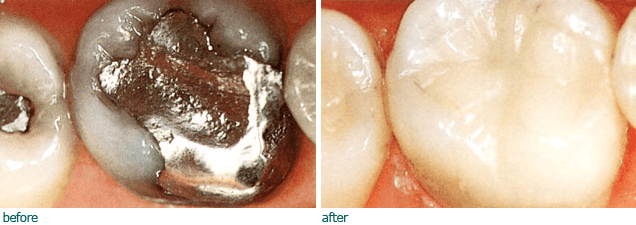
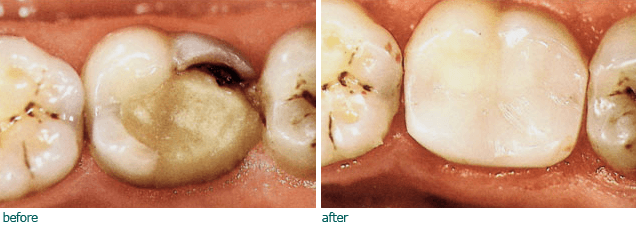
CEREC restorations can be made and fitted at the chairside. This saves on the hygiene costs of the second session. And your patients gain too: no impressions; no temporaries! Fascinating treatment with an excellent result about which patients are bound to tell their friends, acquaintances and relatives.
Broken Teeth / Fractured Teeth
Although in some cases cosmetic contouring is an ideal treatment by itself, it also can be useful in conjunction with most other esthetic procedures. For example, if you are having one or more of your teeth treated with bonding, veneers, or crowns, your dentist can cosmetically contour adjacent or opposing teeth to create a more attractive and harmonious smile line. Also, cosmetic contouring often is used as a final touch following orthodontic treatment.
Bonding Laminates
Veneers
Although bonding is a quicker and more cost-effective treatment alternative than porcelain veneers, if your adjacent teeth have been rebuilt in porcelain, your fractured tooth should be restored in porcelain. The fractured tooth will match the adjacent teeth more closely because the same material has been used. Porcelain veneers or crowns may also be a preferred option if there are multiple teeth to be restored.
Luminears
The main difference is that Lumineers are made from a special patented cerinate porcelain that is very strong but much thinner than traditional laboratory-fabricated veneers. Their thickness is comparable to contact lenses, and so they are often called contact lenses for your teeth. The main advantage of these ultra-thin veneers is that minimal tooth preparation is required. In other words, very little – if any – of your natural tooth structure needs to be removed through shaving or grinding prior to bonding the Lumineers over your natural teeth. As a result, the procedure is often reversible, since your natural tooth structure is left intact, unlike traditional veneers, where a significant amount of your tooth structure may need to be removed.
Lumineers are so versatile that they can be placed over existing crown and bridge work, without the need to replace them. They are the perfect solution for stained, chipped, discoloured or slightly misaligned teeth.
Crowns
Crowns offer an esthetic solution when little tooth structure remains following a fracture. Crowns may be the best option if you:
- Have lost too much tooth structure to allow contouring or bonding
- Are willing and able to spend more time and money on the procedure
- Want an esthetic solution that allows change in tooth shade and shape
If you fracture a front tooth so badly that there is little tooth structure left, a crown is probably the treatment of choice. If a back tooth fractures, it also may be best to restore it with a crown. The procedure should be performed immediately, especially if the pulp is exposed and living nerves are unprotected.
Cerec 3D
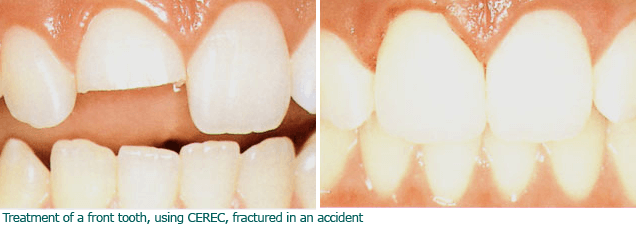
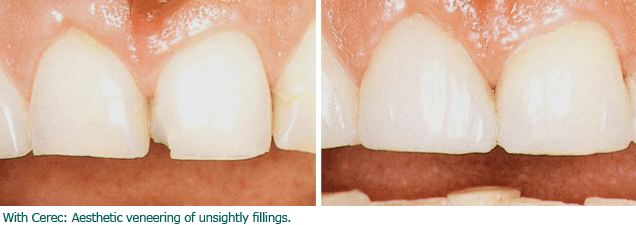
The Solution:
With CEREC you become flexible. For example, by using a thin CEREC veneer with an individually colored undersurface, the surface contour and texture can be modified chairside. Why not give it a try and see just how easy it is to grind and polish CEREC ceramics?
| Cosmetic Contouring |
Bonding |
Porcelain Veneers |
Crowns |
| Treatment Time |
| 15-60 min |
1 hour per tooth |
2 office visits; 1 hour or more per tooth |
Usually 2 office visits; 1-4 hours on up to 4 teeth (more time needed for additional teeth or more extensive treatment) |
| Maintenance |
| Brush and floss daily. |
Have a professional cleaning 3-4 times per year.Avoid biting down on hard foods and ice, and floss carefully as these teeth can chip easily.See dentist for polishing or repair as necessary.Get yearly fluoride treatment. |
Have a professional cleaning 2-4 times per year.Avoid the use of ultrasonic scalers and air abrasives during hygiene office visits.Take special care when biting into or chewing any hard foods.Use your back teeth to avoid placing torque on the veneer.Get yearly fluoride treatment. |
Avoid biting down on hard foods and ice.Get yearly fluoride treatments.Brush and floss daily.Brush your teeth properly to avoid gum recession that may expose the margin of your crown. |
| Results |
| Teeth can appear straighter immediately |
Most fractures and chips are easily repaired. |
Fractured teeth can be restored or even improved. |
Badly fractured teeth can be repaired and reshaped as desired. |
| Treatment Longevity |
| Indefinite |
5-8 years, with professional finishing once every few years |
5-12 years. |
5-15 years (directly related to fracture, problems with tissues, and decay) |
| Cost |
| £120 |
£180 to £200 per tooth |
£400 to £600 per tooth |
Approximately £400 to £600 per tooth; expect to pay much more if a front tooth must be matched to other teeth |
| Advantages |
| No anesthetic requiredPermanent resultsNo maintenanceMost conservative optionQuickest option |
No anesthetic requiredLittle tooth reduction required.Immediate results.Teeth can be lightened.Less expensive than veneers or crowns. |
Less chipping than bonding.Color change is possible.Excellent bond to enamel.Gum tissue tolerates porcelain well.Can improve entire smile if treating more teeth. |
The dentist can repair the chipped or fractured tooth.Teeth can be lightened to any shade.Some realignment or straightening of teeth is possible. |
| Disadvantages |
| Too much reduction can adversely affect the smile line.Your bite may limit how much of the tooth can be removed.In rare instances, sensitivity may be a problem. |
Can chip or stainHas a limited esthetic lifeMay not be effective for severe fractures |
More expensive than bonding.Difficult to repair if the veneer cracks or chip.Staining may occur between teeth, depending on how the veneer is prepared.Irreversible if much enamel is removed.Usually requires an anesthetic. |
Can fracture.Requires an anaesthetic.Tooth form is altered (most of the tooth enamel is removed).Not a permanent solution.-More expensive than bonding. |
 Give yourself a treat this Easter with our Anti- Wrinkle Therapy
Give yourself a treat this Easter with our Anti- Wrinkle Therapy